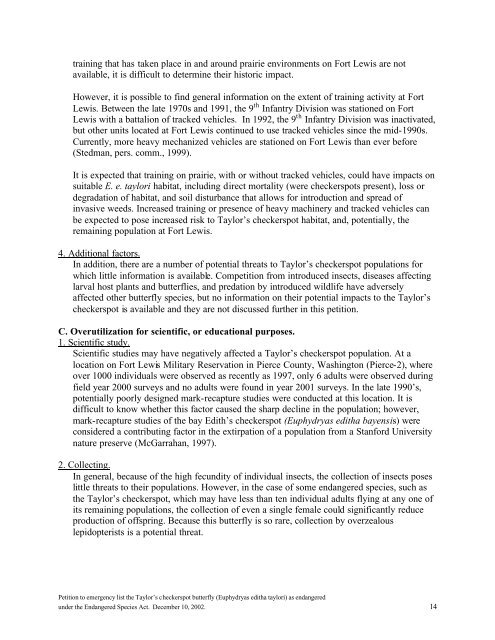petition to emergency list taylor's (whulge) checkerspot - The Xerces ...
petition to emergency list taylor's (whulge) checkerspot - The Xerces ...
petition to emergency list taylor's (whulge) checkerspot - The Xerces ...
You also want an ePaper? Increase the reach of your titles
YUMPU automatically turns print PDFs into web optimized ePapers that Google loves.
training that has taken place in and around prairie environments on Fort Lewis are not<br />
available, it is difficult <strong>to</strong> determine their his<strong>to</strong>ric impact.<br />
However, it is possible <strong>to</strong> find general information on the extent of training activity at Fort<br />
Lewis. Between the late 1970s and 1991, the 9 th Infantry Division was stationed on Fort<br />
Lewis with a battalion of tracked vehicles. In 1992, the 9 th Infantry Division was inactivated,<br />
but other units located at Fort Lewis continued <strong>to</strong> use tracked vehicles since the mid-1990s.<br />
Currently, more heavy mechanized vehicles are stationed on Fort Lewis than ever before<br />
(Stedman, pers. comm., 1999).<br />
It is expected that training on prairie, with or without tracked vehicles, could have impacts on<br />
suitable E. e. taylori habitat, including direct mortality (were <strong>checkerspot</strong>s present), loss or<br />
degradation of habitat, and soil disturbance that allows for introduction and spread of<br />
invasive weeds. Increased training or presence of heavy machinery and tracked vehicles can<br />
be expected <strong>to</strong> pose increased risk <strong>to</strong> Taylor’s <strong>checkerspot</strong> habitat, and, potentially, the<br />
remaining population at Fort Lewis.<br />
4. Additional fac<strong>to</strong>rs.<br />
In addition, there are a number of potential threats <strong>to</strong> Taylor’s <strong>checkerspot</strong> populations for<br />
which little information is available. Com<strong>petition</strong> from introduced insects, diseases affecting<br />
larval host plants and butterflies, and predation by introduced wildlife have adversely<br />
affected other butterfly species, but no information on their potential impacts <strong>to</strong> the Taylor’s<br />
<strong>checkerspot</strong> is available and they are not discussed further in this <strong>petition</strong>.<br />
C. Overutilization for scientific, or educational purposes.<br />
1. Scientific study.<br />
Scientific studies may have negatively affected a Taylor’s <strong>checkerspot</strong> population. At a<br />
location on Fort Lewis Military Reservation in Pierce County, Washing<strong>to</strong>n (Pierce-2), where<br />
over 1000 individuals were observed as recently as 1997, only 6 adults were observed during<br />
field year 2000 surveys and no adults were found in year 2001 surveys. In the late 1990’s,<br />
potentially poorly designed mark-recapture studies were conducted at this location. It is<br />
difficult <strong>to</strong> know whether this fac<strong>to</strong>r caused the sharp decline in the population; however,<br />
mark-recapture studies of the bay Edith’s <strong>checkerspot</strong> (Euphydryas editha bayensis) were<br />
considered a contributing fac<strong>to</strong>r in the extirpation of a population from a Stanford University<br />
nature preserve (McGarrahan, 1997).<br />
2. Collecting.<br />
In general, because of the high fecundity of individual insects, the collection of insects poses<br />
little threats <strong>to</strong> their populations. However, in the case of some endangered species, such as<br />
the Taylor’s <strong>checkerspot</strong>, which may have less than ten individual adults flying at any one of<br />
its remaining populations, the collection of even a single female could significantly reduce<br />
production of offspring. Because this butterfly is so rare, collection by overzealous<br />
lepidopterists is a potential threat.<br />
Petition <strong>to</strong> <strong>emergency</strong> <strong>list</strong> the Taylor’s <strong>checkerspot</strong> butterfly (Euphydryas editha taylori) as endangered<br />
under the Endangered Species Act. December 10, 2002. 14
















